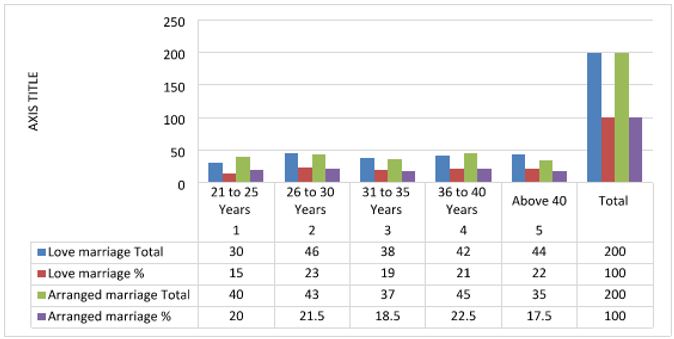Age Dynamics and Power Relations in Love and Arranged Marriages: A Comparative Study
DOI:
https://doi.org/10.5281/zenodo.16352058Keywords:
love marriage, arrange marriage, relations, indian societyAbstract
This study explores the comparative age dynamics in love and arranged marriages, focusing on how age groups influence marital stability and power relations. Based on a quantitative survey of 400 respondents across Ahmedabad, Baroda, Rajkot, and Surat, the research analyzes the age distribution patterns among divorced couples. Results reveal that early divorces (ages 21–25) are more prevalent in arranged marriages, while middle-aged divorces (ages 36–40) are also higher in arranged settings. In contrast, love marriages show a relatively lower rate of divorce in older age groups. The study uses statistical tools including percentage analysis, mean, mode, and standard deviation.
Downloads
References
Allendorf, K., & Ghimire, D. J. (2013). Determinants of marital quality in an arranged marriage society. Social Science Research, 42(1), 59–70.
Bhagat, R. B., & Unisa, S. (2006). Reproductive health in India: Concerns for social change and continuity. Rawat Publications.
Bloom, S. S., Wypij, D., & Das Gupta, M. (2001). Dimensions of women’s autonomy and the influence on maternal health care utilization in a north Indian city. Demography, 38(1), 67–78.
Chowdhry, P. (2007). Contentious marriages, eloping couples: Gender, caste, and patriarchy in northern India. Oxford University Press.
Desai, S., & Andrist, L. (2010). Gender scripts and age at marriage in India. Demography, 47(3), 667–687.
Dommaraju, P. (2016). Divorce and separation in India. Population and Development Review, 42(2), 195–223.
Fuller, C. J., & Narasimhan, H. (2008). Companionate marriage in India: The changing marriage system in a middle-class Brahman subcaste. Journal of the Royal Anthropological Institute, 14(4), 736–754.
Jejeebhoy, S. J., & Sathar, Z. A. (2001). Women’s autonomy in India and Pakistan: The influence of religion and region. Population and Development Review, 27(4), 687–712.
Medora, N. P., Larson, J. H., & Dave, P. (2002). Attitudes toward love and arranged marriages among college students in India. International Journal of Sociology of the Family, 30(1), 75–91.
Netting, N. S. (2010). Love and arranged marriage in India: A cultural dilemma? Journal of Comparative Family Studies, 41(1), 95–112.
Raschke, H. J. (1977). Mate selection and marital adjustment. Journal of Marriage and the Family, 39(3), 515–526.
Singh, S., & Samara, R. (1996). Early marriage among women in developing countries. International Family Planning Perspectives, 22(4), 148–175.
Uberoi, P. (2006). Freedom and destiny: Gender, family, and popular culture in India. Oxford University Press.

Published
How to Cite
Issue
Section
ARK
License
Copyright (c) 2025 Panchal Maulik Krushnalal, Amarjeet Kumar

This work is licensed under a Creative Commons Attribution 4.0 International License.
Research Articles in 'Social Science Journal for Advanced Research' are Open Access articles published under the Creative Commons CC BY License Creative Commons Attribution 4.0 International License http://creativecommons.org/licenses/by/4.0/. This license allows you to share – copy and redistribute the material in any medium or format. Adapt – remix, transform, and build upon the material for any purpose, even commercially.










